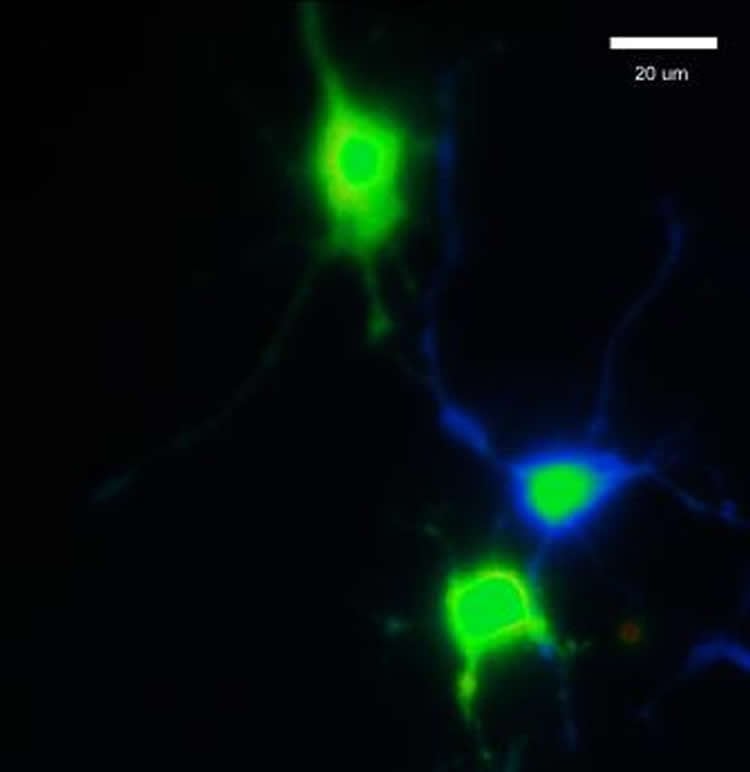Summary: Researchers report specific alterations in signaling circuits associated with memory can induce an abnormal response in neurons, which is linked to the aging process and cognitive decline.
Source: Instituto de Medicina Molecular.
A study led by Luísa Lopes, Group Leader at Instituto de Medicina Molecular João Lobo Antunes (iMM; Portugal) and published today in the prestigious journal Molecular Psychiatry, describes a new mechanism involved in memory loss associated with aging. The work developed over 3 years by a team of Portuguese, French and German scientists now shows that specific changes in the signaling of circuits involved in memory induce an abnormal response of the neurons in the brain that is associated with aging. Understanding these processes is crucial in defining new therapeutic strategies as aging is the greatest risk factor for neurodegenerative diseases.
The researchers studied the brains of elderly patients and found for the first time that an adenosine receptor, called A2A (caffeine target in the brain) is specifically located in neurons. “We already knew that this receptor was increased under these conditions, but little was known about the type of cells in which the receptors would actually be located. We have demonstrated that these receptors are mainly concentrated in neurons, and less in glial cells, at least in elderly patients, “explains Luísa Lopes, iMM researcher and leading scientist of the study.
To better understand its function, the team of researchers generated an animal model that reproduces the increase of adenosine receptor in the same brain areas as those observed in patients. The team found that in these neurons, there is an increased release of glutamate, the most abundant neurotransmitter in the brain. Using a combination of electrical records and calcium measurements it was possible to detect that under these conditions an overactivation of glutamate signaling occurs. “Just by altering the amount of the adenosine receptor in hippocampal and cortex neurons we induced a profile that we have called early aging, as it causes cognitive deficits and changes in neuronal transmission,” explains Mariana Temido, the first author of the study and student of the iMM BioMed PhD programme.

“To prove the importance of this finding, we wanted to test if the same mechanism occurs in older animals and not only in our model. On the one hand we have demonstrated that the overactivation of glutamate receptors is detected in elderly animals. On the other hand, we have shown that the A2A receptor is indeed involved in this circuit, because when we blocked its action, we normalised both neuronal function and reversed memory deficits, “says Luísa Lopes.
This work opens new perspectives for the design of drugs that regulate this new aberrant signaling, namely the caffeine family that was also tested effectively in the study. In addition, it allows to create new models that are useful in the understanding of aging.
Funding: The work was funded by Fundação para a Ciência e Tecnologia, Maratona da Saúde, Santa Casa da Misericórdia, ERDF, Région Hauts de France , ADORATAU, SPREADTAU, LECMA/Alzheimer Forschung Initiative, Programs.
Source: Instituto de Medicina Molecular
Publisher: Organized by NeuroscienceNews.com.
Image Source: NeuroscienceNews.com image is credited to Mariana Temido, iMM.
Original Research: Open access research for “Age-related shift in LTD is dependent on neuronal adenosine A2A receptors interplay with mGluR5 and NMDA receptors” by Mariana Temido-Ferreira, Diana G. Ferreira, Vânia L. Batalha, Inês Marques-Morgado, Joana E. Coelho, Pedro Pereira, Rui Gomes, Andreia Pinto, Sara Carvalho, Paula M. Canas, Laetitia Cuvelier, Valerie Buée-Scherrer, Emilie Faivre, Younis Baqi, Christa E. Müller, José Pimentel, Serge N. Schiffmann, Luc Buée, Michael Bader, Tiago F. Outeiro, David Blum, Rodrigo A. Cunha, Hélène Marie, Paula A. Pousinha & Luísa V. Lopes in Molecular Psychiatry. Published June 27 2018.
doi:10.1038/s71380-018-0110-9
[cbtabs][cbtab title=”MLA”]Instituto de Medicina Molecular “Insights Into Amyloids Associated with Alzheimer’s and Type 2 Diabetes.” NeuroscienceNews. NeuroscienceNews, 27 June 2018.
<https://neurosciencenews.com/age-memory-loss-9461/>.[/cbtab][cbtab title=”APA”]Instituto de Medicina Molecular (2018, June 27). Insights Into Amyloids Associated with Alzheimer’s and Type 2 Diabetes. NeuroscienceNews. Retrieved June 27, 2018 from https://neurosciencenews.com/age-memory-loss-9461/[/cbtab][cbtab title=”Chicago”]Instituto de Medicina Molecular “Insights Into Amyloids Associated with Alzheimer’s and Type 2 Diabetes.” https://neurosciencenews.com/age-memory-loss-9461/ (accessed June 27, 2018).[/cbtab][/cbtabs]
Abstract
Age-related shift in LTD is dependent on neuronal adenosine A2A receptors interplay with mGluR5 and NMDA receptors
Synaptic dysfunction plays a central role in Alzheimer’s disease (AD), since it drives the cognitive decline. An association between a polymorphism of the adenosine A2A receptor (A2AR) encoding gene—ADORA2A, and hippocampal volume in AD patients was recently described. In this study, we explore the synaptic function of A2AR in age-related conditions. We report, for the first time, a significant overexpression of A2AR in hippocampal neurons of aged humans, which is aggravated in AD patients. A similar profile of A2AR overexpression in rats was sufficient to drive age-like memory impairments in young animals and to uncover a hippocampal LTD-to-LTP shift. This was accompanied by increased NMDA receptor gating, dependent on mGluR5 and linked to enhanced Ca2+ influx. We confirmed the same plasticity shift in memory-impaired aged rats and APP/PS1 mice modeling AD, which was rescued upon A2AR blockade. This A2AR/mGluR5/NMDAR interaction might prove a suitable alternative for regulating aberrant mGluR5/NMDAR signaling in AD without disrupting their constitutive activity.






